NLT Study Bible: Hands-On Review [UPDATED]
“But my child, let me give you some further advice: Be careful, for the publishing of new study Bibles is endless, and carrying more than one in your book bag wears you out”
(modified from Ecclesiastes 12:12, NLT).
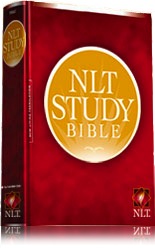
I received the Genesis sampler of the NLT Study Bible (NLTSB from this point forward) a few weeks ago. I literally read every word of it (the same as I had done to the Life Application Bible Gospel of
Mark in the Living Bible way back in the late eighties!) to get a feel for the direction this new study Bible takes. Since last Friday, upon receiving an advance copy of the entire Bible in the mail, I have spent a good bit of time reviewing the full product as well. At this point I can readily suggest that the NLTSB really does bring something new to the already crowded study Bible table.
The NLTSB contains lots of great features that I’m not going to spend a whole lot of time discussing since a number of other reviews are starting to show up on the web that do a fine job covering these. You can “Tour the Features” on the NLTSB website. Also, you can see a list of the contributors at the website as well--a veritable “who’s who” of Evangelical scholarship, but one that represents mainstream thought and offers a variety of perspective within certain boundaries.
IN KEEPING WITH WHAT HAS GONE BEFORE. I have no doubt that study Bibles are big business. And it seems to me that a translation has reached a certain level of acceptance when it begins to show up on shelves in study Bible forms. Study Bibles come with different approaches. There are study Bibles written from the viewpoint of an individual (Scofield, Ryrie, Dakes, MacArthur). Recently there has been a trend for study Bibles to come wrapped around a particular subject (apologetics, archaeology, literary features) or even specific theological perspectives. These two categories are fine if a reader really like the viewpoint of a particular individual or if the reader has interests in a particular subject and wants to discover how that subject relates to Scripture. But for me, I’ve always felt a bit more comfort in study Bibles that offer information of a more general nature and ones that have the perspective of not one particular writer or theological viewpoint, but from from the work of many individuals. In the last two decades, the NIV Study Bible has reigned supreme in this realm as a kind of standard that most study Bibles most often get compared to. The NIV Study Bible has even been adapted to three other translations: the KJV, NASB, and TNIV. Other committee-produced study Bibles in this kind of category include the New Oxford Annotated Study Bible, the Life Application Study Bible (also adapted to numerous translations) and the Jewish Study Bible, to name a few.
2008 sees two new study Bibles in the multiple-contributor category, and that is the NLT Study Bible, the subject of this review as well as the forthcoming ESV Study Bible. And in addition to the kind of standard (at least for Evangelical circles) set by a work like the NIV Study Bible, I would suggest that although it may not be at first apparent, there is another study Bible that is influential upon the NLT Study Bible. I’m referring to the NET Bible with its 60K+ notes. Although as of yet, not widely accepted, he NET Bible raised the bar in a number of ways for study Bibles, and in my opinion its influence is seen in at least three areas in the NLTSB.
The first is the NLTSB’s greater interaction with the original languages. It’s not uncommon to see transliteration of Greek and Hebrew words in the NLTSB’s study notes, even transliterated words beyond those defined in the NLTSB’s brief word study dictionary (more about that to come). Any reader familiar with the NET Bible knows that original language words are regularly incorporated into the notes both in their Greek and Hebrew form as well as a transliteration. The NLTSB offers only transliteration, but this probably suffices for the majority of its target market.
Second, like the NET Bible [print version], the NLTSB intermixes textual notes of the translation with its other notes. This is actually my largest criticism for the NLTSB. The NET Bible can get away with intermixing its textual notes because ALL of the notes came from the translation committee. Reading the NET Bible’s notes is like sitting in on an extended translator’s meeting. As with any translation, I’m very much interested in the footnotes added to the NLT text by the translators as a completely different level of authority and importance from the commentary of the study Bible itself. So the fact that the new 2007 edition of the NLT has a footnote in Gen 10:15 for “Hittites,” reading “Hebrew ancestor of Heth” is totally lost on me because I can’t distinguish it from the rest of the study notes. Even though the study notes in the NLTSB offer an explanation of the footnote, I have no indication that the original footnote itself is from the translation committee. There’s not even an indicator within the text itself that the word “Hittites” required clarification by the translators. If there was one major feature I’d recommend changing in the NLTSB in subsequent printings, it would be to separate the translator’s notes from the commentary.
Another influence of the standard set by the NET Bible: while the number of notes are at a greater number than some study BIbles (the NLTSB boasts 25,900 vs. the NIV Study BIble’s 25,000), these notes in the NLTSB are shorter and more to the point.
But what kind of notes are these? A few weeks back, I asked Tyndale if the study notes in the NLTSB were merely a condensation of Tyndale’s Cornerstone Biblical Commentary series which is also based on the NLT. I was told that it is not, and in fact the study notes in the NLTSB are entirely new, written specifically for the NLTSB (plus, the Cornerstone series is not complete yet).
SO WHAT’S DIFFERENT HERE? One of the promotional charts for the NLTSB compares the approach of it to other popular study Bibles. This is marketing copy, of course, so its value to you will vary, but the various study Bible approaches described this way:
“Using the NLT Study Bible is like being led through Scripture by a caring Bible teacher.”
“Using the NIV Study Bible is like being led through Scripture by a historian.”
“Using the Archaeological Study Bible is like being led through Scripture by an archaeologist.”
“Using the MacArthur Study Bible is like being led through Scripture by a theologian.”
Now, some may argue with any of those explanations on a variety of fronts, but the one major-selling study Bible I saw missing from this list was Tyndale’s own Life Application Study Bible. So I asked Tyndale how the two Bibles differed. I was told that “The Life Application Bible is like being led through Scripture in a discipleship program or by an application-oriented exegete.”
Okay, so the NLTSB is different because, to quote Sean Harrison from the NLTSB Blog,
“Basically, the NLT Study Bible focuses on the meaning and message of the text as understood in and through the original historical context. I don’t see other study Bibles focusing so fully on that. Some study Bibles focus on helping people to accept a particular doctrinal system, while others focus on “personal application.” Others simply provide interesting details about the context, language, grammar, etc., without asking how that information will impact people’s understanding of the text. Still others focus on a particular type of study methodology—topical study, word study, etc. Our goal, by contrast, was to provide everything we could that would help the readers understand the Scripture text more fully as the original human authors and readers themselves would have understood it.“
Of course these kind of descriptions can often overlap. I can see the difference from the Life Application Study Bible, but is the NLTSB all that different in approach from the NIV Study Bible (and its cousins)? Well, you will have to decide for yourself, but I do think it does a few things better, and I will describe those below.
And on a related note, in spite of distinguishing the NLTSB from the Life Application Bible, some notes such as the one discovered by blogger David Ker would make one wonder if there’s not an overly homiletical interest in some of the notes. So, maybe there actually is here and there, but they aren’t necessarily the norm. In fact, as I pointed out in the comments to David’s blog, if you turn to the notes at the other end of the Bible in a book like Revelation, I don’t see any of these kind of preachy statements such as in the last sentence of David’s example. In fact, to quote myself, “[the notes in Revelation] tend to stay with the text, illuminating yes, but not falling into homiletical application. The notes on Revelation also refreshingly tend to avoid any overt connections with interpretational schemes.” The Revelation notes, by the way, were written by Gerald Borchert.
Since the study notes for different biblical books were written by different writers, there may be some consistency issues, but David’s example does not seem to be the norm.
Really, there’s not going to be an unexpected twist to my review. I believe the NLTSB is a solid product. Having said that, however, there are a number of areas in which I believe the NLTSB does things exceptionally well. These are described below.
INTRODUCTIONS WITH SUBSTANCE. Anyone familiar with study Bibles expects to read a one to two page introduction before each biblical book. Included in that introduction are the obligatory sections of author, time of writing, type of literature and an outline. This is where the NLTSB goes above and beyond. Before one ever comes to the introduction to Genesis, the reader will find a four-page, three-column introduction to the Old Testament as a whole. Following that is a four-page essay and table on archaeological sources for Old Testament background. Then the reader finds a separate three-page, three-column introduction to the Pentateuch. Only then will the reader find the expected introduction to the book of Genesis. Thus the NLTSB begins to approach the state of not only functioning as a study Bible but an introduction to the Bible as well.
Of course since study Bibles are usually aimed at a more mainstream audience, I’m always interested to see how such resources handle discussions such as authorship. It doesn’t surprise me for an Evangelical resource such as the NLTSB to reject Wellhausen’s Documentary Hypothesis (my own study and convictions reject it as well). However, I remember being gravely disappointed that in the original 1985 NIV Study Bible that this major theory of Pentateuchal origins could be so easily dismissed in one short sentence. Taking a much different approach, I was pleased to see that in the NLTSB, the issue is not so easily swept under the rug. Although the Documentary Hypothesis is rejected, it is rejected with seven paragraphs of explanation as to why.
On the other hand, Evangelicals always seem more comfortable (for the most part) with source criticism in the New Testament. So, for instance, in the introduction to the Gospels (which is one of four articles before ever reaching the introduction to Matthew), Markan priority for the Synoptics is accepted as probable and credence is also given to the Q source:
“There are also 250 verses of Jesus’ sayings that are shared by Matthew and Luke but not found in Mark, so most scholars believe that they both used a common source, perhaps oral, referred to as Q (from German Quelle, meaning ‘source’ ).”
Some may be interested to know that there is also a separate introduction to Paul’s pastoral epistles in addition to a general introduction to his work.
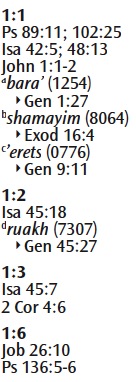
The NLTSB reinvents the cross reference column making it much more useful than merely offering other verses to look up. There are these basic kinds of cross references included, but just enough--not too many. Parallel passages are indicated by two double forward slash marks (//). Asterisks mark intertestamental quotations.
Another new feature in the cross references relate to word studies tied to the original languages. Certain major Hebrew or Greek words are transliterated within the reference column along with its Tyndale-Strong’s number. A reader can look these words up in the “Dictionary and Index for Hebrew and Greek Key Word Studies” in the back of the NLTSB. This dictionary serves as a brief lexicon for about 200 major biblical words. Underneath the reference, a triangled bullet indicates the next occurrence of the particular word much like a chain reference Bible.
Thus the NLTSB manages to combine in its reference system the best qualities of a reference Bible as well as the features of other works such as The Hebrew-Greek Key Study Bible and The Thompson Chain Reference Bible.
RANGE OF SOURCES. Often study Bibles tend to come across as closed systems of reference rather than leading the reader to further information. Many study Bibles simply don’t refer the reader to other works at all. Perhaps this is another influence of the NET Bible which offers references to books and articles right within its notes. While the NLTSB doesn’t do this in the study notes, there is a “Further Reading” section in each introductory article. I was both surprised and delighted to see such a wide range of selections.
These recommendations aren’t relegated to simply Christian writers. Robert Alter, a well known scholar in the Jewish Studies department at Berkeley is recommended further reading for 1 & 2 Samuel. And even among Christian writers, there is a great deal of diversity. Take for instance the introduction to the Book of Psalms. Familiar readers will know there is a VAST difference between the work of James Montgomery Boice on the Psalms and that of Marvin Tate from the Word Biblical Commentary (the latter of whom wrote one of my two recommendation letters to the doctorate program). And in the introductory article on the Book of Daniel, a very traditional scholar like E. J. Young is listed right along with John Goldingay who dates the Book of Daniel much later than the events described therein.
Now, I have to admit that I believe that such diversity among recommended sources is too often sadly rare in some Christian circles. But this demonstrates a confidence in the editors of the NLTSB that readers can make their own informed decisions in regard to the biblical writings. Frankly, such openness is both surprising and refreshing.
Unfortunately, full bibliographic information is not included with the list of further reading recommends, but simply the name of the author and the title of the work--with the exception of volumes from the Cornerstone Biblical Commentary. All completed volumes of the CBC are included in the appropriate lists as would be expected from a Tyndale publication, and the CBC is the only series that enjoys the mention of its name in the “Further Reading” lists. As for the other recommendations, an author’s name and title of the work is probably all one needs to track down any of these volumes at most online resellers.
ACKNOWLEDGING OTHER TEXTS. The writings of the Bible were not written in a vacuum, of course. But from many study Bibles on the market the reader wouldn’t necessarily know otherwise. Sometimes a study Bible will have an included article on the books of the Apocrypha and reasons why Protestants don’t read them, but very little more attention is paid to these books. Most study Bibles include a begrudging reference to 1 Enoch in Jude, but offer little more.
So I was quite amazed Sunday when looking at the article on “Circumcision” that accompanies Acts 15 to read this statement: “For Jews, it had religious significance as the sign of the covenant that God had established with the people of Israel (7:8; Gen 17:9-14; Josh 5:2; John 7:22; Sirach 44:20).” Yes, right along with references to other biblical books was a reference to the Apocrypha. So I looked further, and I found that references to other Jewish literature abounds in the study notes! The note for Romans 4:1 refer the reader to the Prayer of Manasseh, Jubilees, 1 Maccabees and Sirach by way of background. The note for Matt 5:31 quotes the Mishna! I can’t recall seeing so much interaction with extrabiblical Jewish literature in any other study Bible from an Evangelical publisher ever before.
Two more features of note: (1) a five-page, three-column article with timeline titled “Introduction to the Time After the Apostles” follows Revelation describing the process of canonization; (2) the “NLT Study Bible Reading Plan” incorporates all the additional articles and introductions and if followed five days of the week can be completed in five years.
WHAT’S NEXT? The NLTSB won’t be widely available until it hits the retailers mid-September. However, Tyndale has quite a few events coming up in conjunction with the release of the NLTSB. In August, the complete text and all the features of the NLTSB will be released on the internet. This will include fully searchable text with hyperlinked cross references. Unlimited access comes with the purchase of any NLTSB, and others can obtain a 30-day free trial.
Also in August, NLTSB General Editor Sean Harrison will host live “webinars” demonstrating features of the Bible and answering questions.
Simultaneous with the release of the NLTSB on September 15, software editions of the study Bible will be made available for three platforms (Libronix, PocketBible, and WORDSearch (What? Where’s the Accordance module?!).
The NLT Study Bible website is great place to keep up with these developments and to explore the features of the NLTSB. There’s an engaging blog at the website and an errata page has already been started. I commend Tyndale for the errata page as there’s bound to be errors in a project of this scale, and they’re honest enough to make them known (if only this had been done for Zondervan’s Archaeological Study Bible which was rife with errors).
And if you weren’t able to get your hands on one of the early copies of the NLTSB, be sure to place yours on pre-order.
Overall, I’m impressed with the features of the NLT Study Bible, and I truly believe it is yet another step in facilitating the New Living Translation as a choice for serious Bible study.
ONE MORE THING. I failed to mention that the NLTSB breaks with the recent trend for small type in study Bibles by offering a surprisingly larger and readable typeface. The type in the NLTSB is larger than the typeface in the Archaeological Study Bible, the TNIV Reference Bible and even the TNIV Reference Bible. Tyndale was able to do this by opting for a more traditional two-column biblical text instead of a single-column as with most recent study Bibles. Single-column text requires more pages because it does not use space on the page as efficiently as double column text--especially in poetic passages.
Although I’m a fan of single-column text, the larger typeface in the NLTSB is a welcome “feature.” The study notes conserve space even further by using a triple-column layout and thus are easier on the eyes as well.
Wisdom (??) from My Fortune Cookie #6
These places are all the same. Most of them aren’t bad, but they aren’t great either. This one was a bit different in that they had a few more “authentic” items on the buffet such as chicken feet, which they called “Phoenix Claws.” No, I didn’t partake.
So when we received our fortune cookies, mine had this statement:
“You will soon be crossing the great waters.”
What?
I was kind of speechless, so Tim asked me what mine said. “I think mine says that I’m gonna die soon.” I showed it to him, and he thought it was pretty odd, too.
So I motioned to a waitress that was walking by. I showed it to her, but she obviously neither read nor spoke English. Smiling, she simply shrugged her shoulders.
I mean, I know it’s just a fortune cookie. It means nothing. To even think about taking it seriously would be superstitious. But still...
Another waitress came over. Her English was a little better, but not by much. I said to her, “I think it means...” and I drew my finger across my neck in a swift motion. Her eyes grew big and she shook her head.
As we’re walking out, Tim’s reading his fortune to me, adding the words “in bed” at the end and laughing. He tells me that he was taught that trick when he was in elementary school. “Really?” I ask, raising my eyebrows.
As we’re about to leave, the hostess stops us. “They say you got a bad fortune cookie. This is not possible. All fortunes are good.” Her English was actually a bit more broken than that, but it seems a bit demeaning to write it that way.
I pulled the fortune from my pocket, and read it to her. “‘You will soon be crossing the great waters.’ I think it means I’m going to die,” I said with a lump in my throat.
She puzzled over it for a few seconds and then her face lit up. “No, no. In Chinese culture, water is always a good thing. You’re about to go on a profitable journey. Or something good is going to happen to you.”
“Are you sure?” I ask, “Because it really sounds like it’s saying I’m going to die. I’m going to ‘cross the great waters.’”
“No, no. Good things are going to happen to you very soon.”
I smiled and we left. She had obviously just made that up.
I know, I know. It means nothing. But if this blog suddenly receives no more new content, and you don’t see a “Technical Difficulties” disclaimer, like last time, well... you know what really happened.
Rise of the New Living Translation
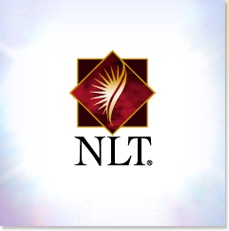
Originally, this week, I was planning to post a preview of the upcoming NLT Study Bible based upon the Genesis sampler I received in the mail over a month ago. I was informed yesterday however, that I would be receiving an advance copy of the entire Bible sometime within the next few days, so that review can wait and I will expand it to cover the entire Bible. Nevertheless, there have been a number of NLT-related issues and trends I’ve been noticing and a number of thoughts have been going through my mind lately. I wondered initially whether I should include them in the review of the NLT Study Bible or treat them separately. I’m going to use this post to do the latter.
THE ELUSIVE COMMON BIBLE. I’ve been collecting and comparing translations of the Bible since my early teenage years. Even after studying biblical languages, I still have a love for English translations, carrying both an English Bible and a Greek New Testament to church on Sundays. Related to that, I’ve watched the trends of what Bibles people carry and read, and I’ve studied the history of English translation development. We live in an age in which we are spoiled by so many translations of the Bible--from every translation methodology and for every niche market. The offset of this fact is that it is now nearly impossible for the church as a whole to embrace ONE Bible as a “common” Bible in the way that the venerable King James Version reigned supreme for nearly three centuries.
And yet even without a common Bible, there is always a preferred Bible, a most often selected, best-selling Bible version. The first Bible version to dethrone King James was the Living Bible in the 1970’s. But this coup was short-lived and the KJV soon regained its kingdom. Nevertheless, it’s interesting to note that the first contender to the KJV for best-selling translation was a Bible that was its complete opposite. The Living Bible wasn’t actually a translation at all, but a paraphrase produced by one man (and later checked by a committee) who had no direct knowledge of the biblical languages. But by the 1970’s the King’s English was quite foreign to the average Christian. Although the Living Bible had many critics at the time, no one argued the fact that it was much easier to understand. And at the time, most Christian homes contained one of those green hardback paraphrases whether it was carried to church or not (and many of them were carried to church).
The Living Bible was certainly not the first Bible to come along with more readable English. Many Bible versions were produced throughout the centuries claiming to the successor to the 1611 “Authorized Version.” Noah Webster and J. N. Darby both attempted to improve upon the KJV in the 19th century. Both of their Bibles were improvements, in the opinions of most, but they never saw widespread acceptance. The 1881 Revised Version and 1901 American Standard Version both sought to replace the KJV as the standard translations for English-speaking Protestants, but while technically translated with more accuracy than the KJV, they did not reflect the beauty of the KJV’s style and never gained wide reading outside primarily academic circles.
In the mid-twentieth century, the Revised Standard Version replaced the KJV for many mainline Protestants, but most Evangelicals looked upon certain renderings in the RSV with suspicion. Thus, the KJV was still able to retain its dominion for a couple of decades more, but its reign as best-selling and most read translation was drawing to a close.
ROYAL DETHRONEMENT. Ultimately, it was the 1978 NIV that would finally and permanently unseat the KJV from the #1 spot. The NIV had a number of things going for it that made it successful where other contender translations had failed. Unlike the Living Bible, the NIV was an actual translation from the Greek and Hebrew texts and was produced by a committee of translators. Reading level was seriously taken into consideration in developing the NIV. The average American reads at a 7th grade reading level and newspapers generally read at that level, too. Considering the fact that the New Testament was written in Koine (common) Greek, why should a Bible be difficult to read? Why should it sound like it was written in a bygone era? Further, unlike the Modern Language Bible, the NIV committee employed stylists that helped keep its translation consistent. While not trying to achieve the majesty of the KJV necessarily, the NIV committee did achieve something that other contenders had not: an accurate, consistent, and readable translation of the Bible. I don’t remember now exactly when it occurred--either in the late eighties or sometime in the nineties--but the NIV became the best-selling, most-used, and most read translation. For millions of people, it opened up the Scriptures and made them readable for the first time.
But let’s be realistic. The NIV is not going to be the Bible of choice for the next three centuries like the KJV was. No translation will ever last that long again because the English language changes too quickly in the modern age. Sadly, the 1978 NIV already sounds a bit dated. And although it is still the best-selling English translation of the Bible, I would suggest that over the next decade another translation is going to replace it in the top spot. I don’t have access to NIV sales figures, but I would guess that its sales are already on the decline. If they aren’t, they will be soon.
WHAT’S NEXT? So what are the contenders? The English Standard Version, Holman Christian Standard Bible, Todays New International Version, the New Living Translation (second edition)--these are all major 21st century translations. If I had been propheticlly looking at this list twenty years ago, it would have been easy to suggest that the TNIV, as an update to the NIV, would be the inheritor of the NIV’s mantle. Even up until recently, I thought it still could be. But I’m less and less certain of that fact.
The TNIV suffers on two fronts: (1) It was the target of a major disinformation campaign that has led to its rejection by many of those who should have been in its target audience; and (2) neither the TNIV’s copyright owner, the International Bible Society, or its major United States distributor, Zondervan, have ever given it precedence over the original NIV in terms of promotion and emphasis.
In regard to the first issue, 50% of stores that belong to the Christian Booksellers Association, including major chains such as Lifeway, refuse to carry the TNIV. Supposedly the TNIV’s primary offense is inclusive language; however, these same stores that won’t carry the TNIV will carry the NLT, the Message, the NCV, the NRSV and others that do contain inclusive language. Further, translation such as the ESV, NASB95, and the HCSB all contain more inclusive language than even the original NIV. This is a heinous double standard. Changing these misconceptions will also require a major re-education campaign on the part of Zondervan and the IBS.
As for concerns with the International Bible Society’s and Zondervan promotion of the TNIV, in March of 2007, I wrote an open letter to both organizations here on This Lamp expressing my concerns. IBS never responded, but Zondervan flew me up to its headquarters in Grand Rapids, Michigan, where I met with editors and marketers--all warm, friendly, and welcoming. I didn’t meet anyone who wasn’t absolutely adamant that the TNIV was the future. I also came to understand better why the company was not in a position to completely remove the NIV from the market. Fine. But there’s evidently a breakdown somewhere.
Run this little experiment. Go to Amazon.com and search for “New International Version.” Then to narrow your results, click on “Books” under “Any category” on the left. Now, change the drop down on the top right to “Publication date.” I count 29 new NIV Bibles already projected for 2009. Run the same search for “Today’s New International Version.” The result? Nothing. You will find results counting new editions for 2008, but in comparison to the new NIV editions for this year, you’ll definitely see where Zondervan’s emphasis is. You ask anyone at Zondervan and they will tell you that the TNIV is the future. But the company simply doesn’t seem to be willing to put that into practice. I’m certain that they fully intend to eventually switch emphasis to the TNIV, but my fear is that by the time they do this, it may be too late for it to matter.
INTERESTING RECENT DEVELOPMENTS. Now, let me show you another interesting indicator of what may be the shape of things to come. Below is the August 2008 translation bestseller list from Christian Booksellers Association. These figures reflect sales from the month of June, 2008.

Now, anytime I show CBA translation charts, I always feel obligated to offer a disclaimer. These charts do not reflect the huge number of Bibles sold in non-member stores and bookstore chains including Barnes and Noble and Borders and such. They do not include the sales of retail outlets like Wal-Mart and online retailers like Amazon.com--all of which sell large numbers of Bibles, also. Although some Catholic stores are CBA members, the majority are not; so Catholic translations are never well-represented here. Also, keep in mind that as I have already pointed out, roughly 50% of CBA stores refuse to carry the TNIV, so although it does not show well here, that doesn’t mean that it’s not selling elsewhere. Translations such as the NRSV may also have higher sales that are simply not reflected here. The JPS is a fine translation, but it’s never going to make this list. Okay...
Nevertheless, the above figures do represent an extremely large number of Bibles sold in stores, especially Bibles that Evangelicals are buying. Since we don’t have any actual numbers, obviously the charts are open to a good bit of interpretation. Years ago, while working in a bookstore, I saw a document with some actual numbers. The first three entries counted for the vast majority of all sales. And by the time a translation ranks in the bottom half, we’re usually talking about sales in the single digit percentages.
First let’s look at the charts in regard to the TNIV. The fact that it ranks on dollar sales, but not on unit sales probably means that there aren’t that many inexpensive TNIVs in bookstores. So there aren’t many people buying low cost editions in CBA stores for evangelistic purposes. But what’s surprising is that the TNIV has completely dropped off the units sold chart. So, while it is not carried in every one of these stores, it at least used to still show in the units sold list. The August chart doesn’t mean that the TNIV is not selling in the stores that are carrying it, but it does mean that it has recently been selling less. And I’m sorry, but it boggles my mind that the International Children’s Bible would outsell the TNIV!
But now, let’s look at the chart in regard to the New Living Translation. For the last few years, the NIV, KJV, NKJV and NLT have remained in the top four positions (the HCSB was in the 4th spot after its release for a little over a year). The KJV and NKJV often go back and forth between second and third place, but the NLT is usually ranked fourth.
The unit sales chart has the most significant change. For the first time to my knowledge, the NLT has topped both the KJV and NKJV in unit sells, setting it second only to the NIV. And in dollar sales, it is ranked third and above the NKJV. To my knowledge, the NLT--which has always done fairly well on these charts anyway--has never done this well.
This week, I noticed another interesting development. Over at the NLT Blog, in what was almost an aside comment, it was noted that “Christianity Today, International will be making the NLT the default translation on their websites.” I assume that the NLT is replacing the NIV as the default translation. In my mind, this is an incredibly significant development as Christianity Today, in many ways, represents mainstream Evangelical thought. So it speaks volumes not only to the fact that the NLT was chosen as default translation, but also in regard to the versions that were passed over.
NLT UNDER THE RADAR. Suddenly and seemingly unexpectedly, signs are starting to point to the New Living Translation as a major contender for the spot of top English translation that the NIV has held onto for the last two decades. How did this come about?
Perhaps the success of the NLT can be chalked up to the patient persistence on the part of Tyndale House Publishers as well as near nonstop fine tuning of the translation itself. When the New Living Translation was initially released in 1996, it was far more to the right on the dynamic equivalence scale than it is now. The first edition had many phrasings that still echoed Ken Taylor’s original Living Bible. But with the release of the second edition of the NLT in 2004, a lot of the more dynamic readings were tightened up, active voice replaced passive voice in many passages, and the more questionable renderings were mostly removed. Echoes of the original Living Bible are now all but gone from recent editions of the NLT. I still consider the NLT a dynamic translation, and the best of its breed, but it has now moved much closer to the middle, much closer to the kind of translations I would normally categorize as median translations, containing elements of both formal and dynamic methods, based upon the communicative issues of a particular passage.
In 2007, the NLT was revised yet a third time. But the changes are not as startling as the shift between the first and second edition (see my review of the NLT for discussion of the changes in the second edition). In fact, Tyndale is still referring to the 2007 edition as a second edition, but adding 2007 to the 1996 and 2004 dates. With each revision, the NLT has become...well, I don’t want to say “more literal,” because it’s certainly not a literal translation in the traditional sense of meaning. But it has certainly become less dynamic.
I do not yet have a full 2007 text of the NLT, but when I received the Genesis sampler of the NLT Study Bible, one of the first things I did was to compare the changes in the text from the 2004 edition. As already mentioned, the changes are not on the same level of the change between the 1996 and 2004 editions, in which the NLTse was almost an entirely new translation in my opinion. But the changes reflect a honing of the translation, a fine-tuning of the details if you will. Consider that in Genesis 1-12, there are only 7 verses out of 287 that have been changed from the 2004 edition. That results in a 2.4% change from the 2004 NLTse.
1996 |
2004 |
2007 |
|
1:14 |
And God said, "Let bright lights appear in the sky to separate the day from the night. They will be signs to mark off the seasons, the days, and the years. | Then God said, "Let great lights appear in the sky to separate the day from the night. Let them mark off the seasons, days, and years. | Then God said, "Let lights appear in the sky to separate the day from the night. Let them be signs to mark the seasons, days and years. |
1:16 |
For God made two great lights, the sun and the moon, to shine down upon the earth. The greater one, the sun, presides during the day; the lesser one, the moon, presides through the night. He also made the stars. | God made two great lights, the sun and the moon--the larger one to govern the day, and the smaller one to govern the night. He also made the stars. | God made two great lights--the larger one to govern the day, and the smaller one to govern the night. He also made the stars. |
1:26 |
Then God said, "Let us make people in our image, to be like ourselves. They will be masters over all life--the fish in the sea, the birds in the sky, and all the livestock, wild animals, and small animals." | Then God said, "Let us make human beings in our image, to be like ourselves. They will reign over the fish in the sea, the birds in the sky, the livestock, all the wild animals on the earth, and the small animals that scurry along the ground." | Then God said, "Let us make human beings in our image, to be like us. They will reign over the fish in the sea, the birds in the sky, the livestock, all the wild animals on the earth, and the small animals that scurry along the ground. |
2:5 |
there were no plants or grain growing on the earth, for the LORD God had not sent any rain. And no one was there to cultivate the soil. | neither wild plants nor grains were growing on the earth. The LORD God had not yet sent rain to water the earth, and there were no people to cultivate the soil. | neither wild plants nor grains were growing on the earth. For the LORD God had not yet sent rain to water the earth, and there were no people to cultivate the soil. |
2:10 |
A river flowed from the land of Eden, watering the garden and then dividing into four branches. | A river watered the garden and then flowed out of Eden and divided into four branches. | A river flowed from the land of Eden, watering the garden and then dividing into four branches. |
11:26 |
When Terah was 70 years old, he became the father of Abram, Nahor, and Haran. | When Terah was 70 years old, he had become the father of Abram, Nahor, and Haran. | After Terah was 70 years old, he became the father of Abrah, Nahor, and Haran. |
12:14 |
And sure enough, when they arrived in Egypt, everyone spoke of her beauty. | And sure enough, when Abram arrived in Egypt, everyone spoke of Sarai’s beauty. | And sure enough, when Abram arrived in Egypt, everyone noticed Sarai's beauty. |
Interestingly note that in Gen 2:10, the NLT reverts back to the original 1996 reading. Since writing my initial review of the NLT, I’ve been contacted by a number of NLT1 holdouts. Some people simply prefer the 1996 edition, and my own wife is one of them. Overall, it is more dynamic (though not in Gen 2:10) and that speaks to some people in a greater way. Personally, I have no problem with that, although I believe the changes made in the 2004 edition and now the 2007 revision as demonstrated above are changes for the better.
Over the last few years, I’ve found it quite interesting to watch the TNIV receive criticism in regard to inclusive language when the NLT had used much of the same kind of language almost a decade earlier. I even asked one of the NLT translators about this--why the NLT had remained virtually unscathed while the TNIV took a beating from its detractors. He felt that the TNIV had been a lightning rod for controversy and this allowed the NLT to scoot by a bit under the radar.
And under the radar it is. The NLT has continued to gain readers while improving the translation itself while many have really not realized such changes were going on. Consider that the 2004 update, as radical as it was, barely received mention by Tyndale itself. In fact, when I began planning my review of the NLT in 2006, I was totally unaware the extent of the changes. And I would not have even known about the 2007 revision had a reader of This Lamp not informed me by email.
But if I’m a proponent of the NLT and have been slow to find out about changes to the text, evidently it’s even harder for the detractors. Tim Challies sought to further propagandize the ESV earlier this month by knocking down a few translations he doesn’t like. Evidently, though, he had no idea that the copy of the NLT he was quoting was two editions out of date.
Want further evidence of the NLT’s under-the-radar status? Check out the Wikipedia entries for the ESV, TNIV, and the NLT. The NLT is older than the ESV by five years and the TNIV by nine. The articles for the ESV and TNIV are substantive because they have both been magnets of controversy and have each had their share of supporters and critics. The NLT, on the other hand, doesn’t even have a full article. It’s a stub, and an out of date one at that. Some of the links don’t even work.
Want more? Consider the interview with J. I. Packer from 2006 in which he heartily endorsed the NLT. He even described the NLT as “brilliantly done.” This should be ironic considering Packer was the general editor of the ESV, a translation which in many ways was created to be everything the NLT is not. But it’s not ironic because Packer is not really recommending the NLT as a primary translation. Rather, he thinks of it as a secondary translation, something perhaps to be read beside a more traditional translation like the ESV. He may even think of it in the same vein as the original Living Bible which many used as a simple commentary to the KJV. But the people I see using the NLT are not reading it as a secondary translation. And I can guarantee you that Tyndale is not promoting it to be anything but a primary Bible.
What made the NIV king of the hill beyond its merits as a translation? Well, there were a number of significant editions of the text that were released in the eighties including the NIV Study Bible, the NIV Student Bible and an NIV version of the Thompson Chain Reference Bible. The Expositor’s Bible Commentary, written by top Evangelical scholars demonstrated that the NIV was worthy as a commentary base. The Goodrick-Kohlenberger numbering system tied the NIV’s text to its Greek and Hebrew roots and paved the way for resources like the New International Dictionary of New Testament Theology. Today, there are more modern commentaries based upon the NIV than any other translation.
But now, Tyndale is setting the NLT up for the same kind of reference integration that the NIV has enjoyed. A system known as the “Tyndale-Strong’s numbering system” has been developed to connect the text of the NLT to the original Greek and Hebrew text. In the forthcoming NLT Study Bible, these Tyndale-Strong’s numbers are included right along in the cross reference column next to the text. The Cornerstone Biblical Commentary series and the expanding Tyndale Reference Library relies on the NLT text as well.
Another healthy sign for the NLT can be found in the two NLT-related blogs that have appeared recently. One blog is related to the NLT in general and the other specifically for the forthcoming NLT Study Bible. This is an excellent idea and a wonderful way for Tyndale editors to interact with NLT readers. I made similar recommendations to Zondervan regarding the TNIV as early as two years ago, but an ongoing publisher-based TNIV blog has never become a reality.
Personally, I’ve stated for some time that the NLT is fully capable of being used as a primary English translation for serious study and teaching. Steps are now in place with the growing number of NLT-related resources to make this a reality. And as has been pointed out recently, the NLT translators are no slouches themselves, but rather the cream of Evangelical academia.
LOOKING TO THE FUTURE. In discussing some of these observations with Wayne Leman via email yesterday, he stated “A major translation comes along every few generations and it can become a default translation. The KJV was one of these. The RSV was one, at least for NCC churches. The NIV was one. Now, [in my opinion], the NLT is one. I know that many will disagree with me, but that's okay.” Wayne, who gave me permission to quote him, knows what he is talking about as he is a Bible translation consultant himself and a founder of the Better Bibles Blog.
In my experience, the average Christian really doesn’t pay that much attention to translation issues. I’ve discovered that many people carrying a Bible often can’t tell me what translation they are using without looking at the spine. So, what makes a translation like the NLT rise in popularity, especially among a dozen or so other Bible versions vying for acceptance? I have a hunch that when a person walks into a store looking for a new Bible, he or she opens them up and simply reads various passages. This is where the NLT has the advantage. Without a doubt, of all the major contemporary translations, the NLT’s English sounds the closest to contemporary speech. While some would criticize the NLT for this, we must again remember that the New Testament was originally written in the common speech of the day, not the more formal styles that were used for other, more “official” purposes.
Wayne also wrote yesterday that, “Christian readers today appreciate a Bible version that actually reads as they write and close to how they speak. There have been enough idiomatic English versions around for several decades, so that Christian readers know what good English sounds like in a Bible. If Christian readers have a true choice to purchase a Bible--and don't have to follow the dictates of some ideology--they will often purchase a Bible with good English, at least as a supplement to one that has worse English and is used as their church's pew Bible.”
Readers of This Lamp know that over the past few years when asked for a recommendation for a primary English Bible, I’ve suggested the HCSB, TNIV or NLT. In my own use, the TNIV has been my primary Bible over the last two years, although when I give a Bible to someone who tells me the Bible is difficult to understand, I find that most often I give the NLT. And I’ve done this for well over a decade. In fact, now that I think about it, I’ve given away more NLTs than any other translation in the last ten years, and I have done so because of its superior readability.
I have been teaching from the TNIV the last two years because 70% of those whom I instruct are carrying NIV Bibles. That’s in addition to the fact that I find the TNIV to be an excellent translation. Further, I’ve found that usually a median Bible is best for teaching; although I’ve said that I could use the NLT if enough people in a Bible study or classroom also had the NLT. I’ve often used the NLT in formats that were less interactive such as sermons and devotionals. But the day may be coming in which a majority carries the NLT. If that happens, it would only make sense that I would teach from the NLT. Of course, Tyndale currently lacks a decent NLT reference Bible for teaching or preaching akin to something like the TNIV Reference Bible.
This coming Sunday, I still plan on teaching from the TNIV. But I really wonder what I’ll be teaching from in five years. Could it be that the majority of us will study with the NLT in hand?
I’d really like to have a discussion about this. Let’s avoid the “my translation is better than your translation” kind of nonsense. I don’t believe that for one Bible version to succeed another one must fail. I still recommend reading translations in parallel. Regardless, I believe current trends point to the NLT continuing to gain momentum which may eventually lead to its place as the most used Evangelical translation in a number of years. And it may even be able to reach beyond the walls of Evangelicalism. What do you think? Let me know in the comments.
Still Looking for a Decent iPhone Bible App
One of the best features of iPhone 2.0 is the App Store. But I’m still waiting on two applications that I was fairly dependent upon back when I had my Treo before the iPhone. One is Pocket Quicken which I hope will eventually be released for the iPhone. The other is a decent Bible app. Initially, I was reviewing a number of the original iPhone web-based Bible apps here on This Lamp, but I finally lost interest in it because although some were some apps better than others, none of them really satisfied my needs.
When I had my Treo, I had the Bible Reader software from OliveTree. On my Treo I had installed the Greek New Testament, the NET Bible including its 60 kazillion notes (which I had to keep on a sim card), and the NASB with Greek and Hebrew dictionaries.
Access to English language Bibles abound on the iPhone, buth for web-based apps and now in the App Store. But there’s still no original language texts, and to be honest, none of the current offerings really stands out in my opinion.
One of the Bible apps currently getting a lot of attention seems to be the free Bible app from Lifechurch.TV. It idraws its content from the YouVersion.com website. This means you can switch easily among vairous translation. And it has some good ones, but no Greek or Hebrew.
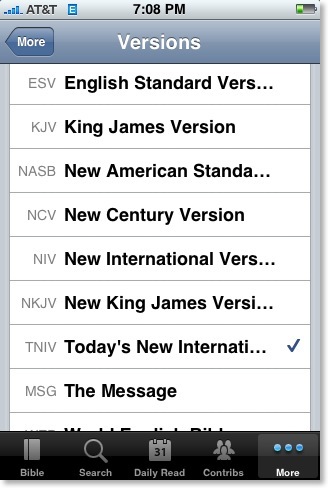
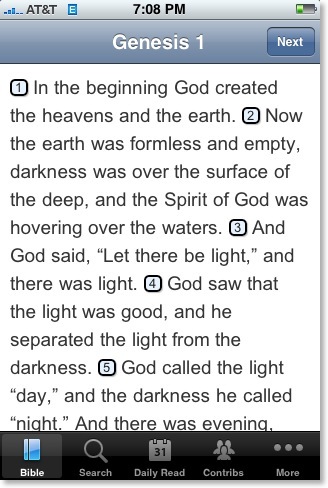
But there’s a catch. Unlike some of the fee-based Bible apps, the Bible app from LifeChurch.TV depends on an internet connection because of its ties to YouVersion. This means that if you are without a signal--Edge, 3G, or Wifi (which is a situation I occasionally find myslef in)--you cannot access your Bible at all. You must be connected to the internet to use this app. At least its free.
I made the mistake of purchasing “Bible Unleashed: NET” in hopes of having the NET Bible with notes on my iPhone. But it doesn’t contain the notes at all, AND it is totally dependent upon the internet for its content. So, I wasted $1.99 on this purchase. A better offering is simply the NET Bible (with notes) available at enetbible.com. It’s a web app, but certainly superior to this one.
Speaking of enetbible.com, I noticed that with the iPhone 2.0 software upgrade, we finally have Hebrew text on the iPhone as seen at the top of this note from Exodus 2:2 in the NET Bible:
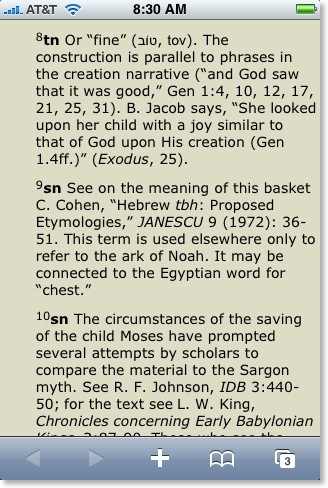
You may remember that the original iPhone software would display Unicode Greek, but not Unicode Hebrew.
I am hopeful that OliveTree or Laridian will develop true self-contained suites of biblical texts available for the iPhone soon.
Finally, another good thing about the new iPhone software is that we can finally make decent screen captures as seen above unlike with the original software in which I had to take photographs of the screen with my camera.
The Kind of Stuff I Find Nowhere Else II
You may remember that last year while in Louisiana, I actually saw a jar of pickle pigs’ LIPS in a jar (again, NO, I didn’t partake) while shopping in a grocery store. Well, this year, when visiting friends and relations a week or so ago, we went to the same store. Yes, the pickled pigs lips are still on the shelf. But this year we took another picture of the kind of stuff you just don’t seem to find in grocery stores outside of Louisiana very often:

Obviously, the alligator filet is the most exotic of the bunch. Note that it says “Certified Cajun.” We didn’t buy any of these items (I’ve actually never eaten aligator). I did look at the packages of pre-cooked and shelled crawfish meat, but it was just as pricey as what I can get here in Kentucky.
The oddest thing we saw in the frozen section at this store is pictured below:

This was in the regular frozen seafood section: “wild caught, head-on” bait shrimp--the kind of stuff you can go fishing with. But notice the top left corner of the box: “Good eating too”! Well, why not, I guess.
I didn’t buy any of the food pictured above. but I did fill up the ice chest with Natchitoches meat pies, crawfish pies, andouille sausage, boudin (regular and jalapeño), purple hull peas, and Albert’s Hot Sauce.
Why eBay Insurance Is Important

I was doing a bit of early Christmas shopping for Kathy, and I had won an eBay auction for a “Sango Sangria Vegetable or Relish Tray” (she likes the Sango Sangria stuff). As you can see above, it didn’t survive the journey. So now, I’m out about $30 after paying for shipping, too, and nothing but a broken tray to show for it.
The insurance which I opted not to get: $1.70.
I was simply being cheap--trying to save less than two bucks. Well, lesson well learned, I suppose.
Whatever you do, don’t tell Kathy.
Recommend: The New Living Translation Blog

I especially appreciated Keith Williams’ “Words in the New Living Translation.” This post directly addressed a recent post by Tim Challies that took swipes at the NLT (and the Message and CEV) in order to prop up the ESV. I found it interesting that Challies would quote from the 1994 edition of the NLT when the translation has seen a significant revision in 2004 and then another minor revision last year. I felt that Challies’ post was primarily another attempt to promote the value of the ESV by attacking Bible versions that use a different method of translation. In the end, such comparisons are apples and oranges, translationally speaking. I don’t see why ESV readers can’t simply applaud their favorite Bible without attempting to knock other versions down, but the internet is full of such posts. Williams’ rebuttal avoided the trap of pitting one translation against another and instead approached the real issue of translational method and the challenge of communicating meaning from one language to another.
The NLT is one of three primary translations (along with the TNIV and HCSB) that I suggest when asked under general circumstances for a translation recommend. Translations, in my opinion, have to be evaluated on their own merits regarding how well they achieve their translational goals. There is no “one size fits all” translation, but the NLT communicates in a style that is more in keeping with contemporary, conversational English than any major translation I know of.
The NLT Blog is described as “Issues, perspectives, and news related to the New Living Translation and Bible Publishing.” A glance at the contributors suggests that this blog will serve as a great way to interact with the keepers of the NLT. They are off to a good start, and I will be interested to see what future posts hold. While I assume they will highlight specific editions of the NLT, I would hope also to see much discussion about the uniqueness of the NLT itself and further discourse on translation method.
Other publisher-based Bible translation blogs:
ESV Blog
NET Bible Revolution (last updated April 30, 2008)
TNIV Blog (defunct? not updated since November, 2006)
Starbucks and "Free" WiFi: They Just Don't Get It

Often I like to get out of my office and work from a coffee shop to get a change of scenery. For these coffee shop hangout sessions, I stopped going to Starbucks a while back in favor of other coffee shops. Why? It’s simple: free wireless internet. When Starbucks first started offering wireless internet, it was through TMobile and it was very expensive--$6 an hour, $9 a day or $30 a month. Those kinds of prices seemed insane, so I started going elsewhere. Just about every other coffee shop has free wireless internet. This is what Starbucks doesn’t understand. Although there coffee is good, I’ll take a lesser cup of Joe if free WiFi is included.
So I was pretty excited when Starbucks announced they were moving from TMobile to AT&T for wireless internet and offering free service through the latter. Of course the “free” AT&T internet is limited to two hours and the patron has to have a registered Starbucks gift card. Okay, that seemed like a short amount of time, but it was better than nothing, so I made sure one of the gift cards loitering in my wallet was registered.
This week and last I’ve been in Louisiana visiting family and friends. I called Philip Wade on Saturday and he suggested we meet at the local Starbucks. Since I wanted to upload a video podcast for the cast iron site while we talked, I got to Starbucks a few minutes early so that I could go ahead and connect and begin the upload.
After ordering my tall black coffee, I opened up my MacBook and selected “AT&T” from the list of wireless networks. I noticed also that TMobile was in the list, too. For some strange reason, the AT&T network switched over to TMobile’s although the screen still showed the AT&T logo. From there, I wasn’t certain what to do.
My screen showed an AT&T logo and asked for my login name and password. There was no mention of Starbucks anywhere on the screen or in the drop down menu. What login name and password? I tried using the same information I had used a few days before on the Starbucks website when I registered my card. No luck.
Not knowing what to do next, and since there’s no Internet access beyond the login screen, it’s not like I could have my login name and password emailed to me, so I approached one of the baristas at the counter. The fellow behind the counter looked at my screen and said that he didn’t know what to do either. Now, consider that this is one of the employees at Starbucks and he has no idea how to get on to his own store’s wireless network. After poking around on the screen for a few minutes, he looked at me and said, “Well, if you sit in the front corner of the store, you can pick up Subway’s internet.”
Unbelievable.
I sat back down at my table. I saw Philip pulling up outside as I looked back down at my screen. There was a link for help, so I clicked on that and saw a toll-free support number for AT&T. As Philip was walking in the door, I was telling the fellow from AT&T what I had tried so far in order to log on. The support fellow seemed totally oblivious. “Did you say that you tried your login?”
“Well, what login do you mean? My Starbucks login, the account number on the Starbucks card or what?”
After I told him I’d tried both, he asked for my name again and tried to look me up in his database. Not finding my name anywhere, he suggested that perhaps my card was not set up for WiFi rewards. What?
Of course, he said that he couldn’t set that up for me. He’d have to give me another number to call where they could supposedly set up my card. I looked at Philip. “Starbucks’ internet is impossible to get on. Do you know of another coffee shop where the internet is free?” Philip suggested PJ’s across the street.
I still had the AT&T guy on the phone. “Do you want that number?” he asked.
“Forget it,” I said. “We’re going somewhere else.”
We went to PJ’s where getting on the internet was as easy as opening my MacBook.
This is why other coffee shops will continue to get my business over Starbucks. As I said, Starbucks’ coffee is great. But in the end, it’s about more than just the coffee--it’s about the experience. And they just don’t get that.
This Lamp Will Be Down on Wednesday
I’m not too thrilled about .Me instead of .Mac by the way. Apple says that both will still work, so I’m not changing my email or web address just yet, but I have to wonder if two or three years down the road they might announce that all mac.com addresses will be no more.
I’ve thought about moving This Lamp to its own dedicated server space with a real thislamp.com address (right now, it only forwards to what you see in your URL line above), but that would also entail a lot of resetting internal links, so right now, I’m undecided.
Regardless, if you drop by on Wednesday and don’t find This Lamp, don’t panic, it should be back within a few hours.
Zondervan & This Lamp to Give Away TEN Renaissance Fine Leather TNIV Reference Bibles
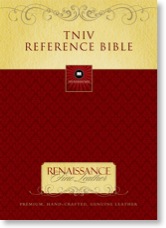
That’s right--Zondervan has offered to give away ten copies of the Renaissance Fine Leather TNIV Reference Bible (a combined retail value of nearly $1,000) to ten qualifying individuals. What must you do to qualify?
- You must be a “Gatekeeper.” What’s a gatekeeper? A gatekeeper in this context is someone who regularly preaches or teaches the Bible in a church or educational setting. For the purposes of this giveaway, if you are a pastor, other minister or teacher of adults and you instruct from the Bible on at least a weekly basis, you are considered a gatekeeper. You should also have been in this position for at least three months.
- You must already use the TNIV as your primary Bible. This is a really nice edition of the TNIV Reference Bible, and Zondervan is being very generous to give these away through This Lamp. So, this is a Bible that’s meant to be used, not one that becomes an addition to your collection of translations.
- In the comments of this post, tell us why you are using the TNIV translation as your primary teaching and/or preaching translation. We’re looking for at least a couple of paragraphs here, not “Because I think it’s really cool.”
- Qualifying winners agree to a follow-up email interview regarding the use of the TNIV in your ministry. Between now and November, I’ll contact you with a few questions based on your post here in the comments. That interview will become the basis of an actual main post here on This Lamp.
- You cannot qualify if you’ve already been deemed a recipient of the similar giveaway on TC Robinson’s website. No double-dipping! And TC emailed me his list of winners!
- Sadly, United States residents only.
If you have any questions, let me know. I’ll post a list of the ten winners once it is finalized.
PLEASE NOTE THAT THIS OFFER HAS NOW ENDED. TEN WINNERS HAVE QUALIFIED.
Preview: TNIV Reference Bible, Renaissance Leather Edition (with photos) [UPDATED]
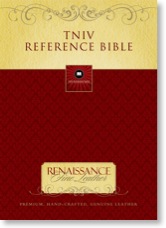
Later this year, Zondervan will release another edition of the TNIVRB, this time with a much nicer cover, described as “Renaissance Fine Leather.” There’s a movement in publishing circles away from naming the animals from which the leather is obtained [I’m still waiting for “genuine dairy cow”], but the new “Renaissance Fine Leather” is
[Update: Okay, here’s the scoop. The Renaissance Fine Leather is cowhide. It is not calf, goat, or pig. I’ve been told that what makes it special is its “Soft supple feel, complemented with stitching accents, & sewn binding.” Further, “the soft supple feel is achieved by the case construction, which has flexible endsheets without a stiff cover board. Some [Renaissance Leather] Bibles also have foam to give it more structure, but maintain the flexibility. So instead of using a thin bookbinding leather and then attaching it to a stiff board (like 99% of Bibles), we use a thicker leather and let the material itself become the cover.”]
The new edition of the TNIVRB has these features:
- November release*
- Over 10,000 references
- Bound in our new premium hand-crafted Renaissance Leather*
- Single Column
- Black letter
- Topical ties at bottom of page
- TWO ribbon markers*
- MSRP: $99.00*
*indicates features pertaining only to the new edition.
I was sent some photos of the new Bible from Zondervan today, which I am reproducing here. Be sure to click on an image to see it in its original size.

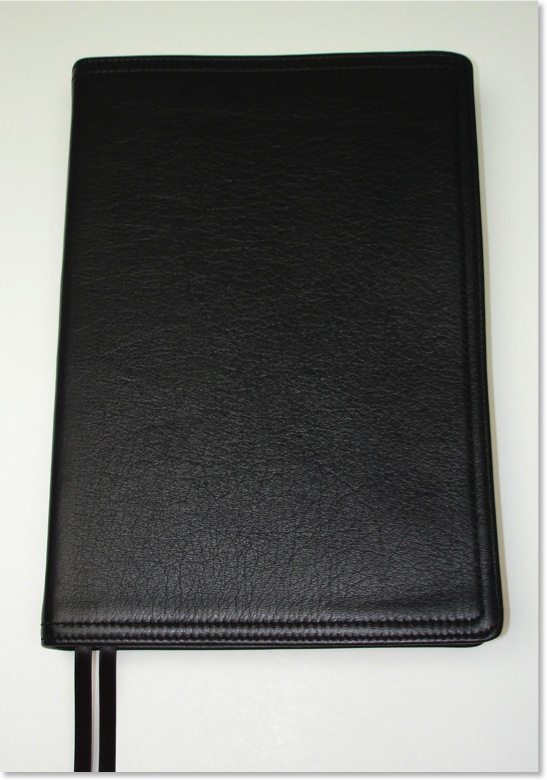
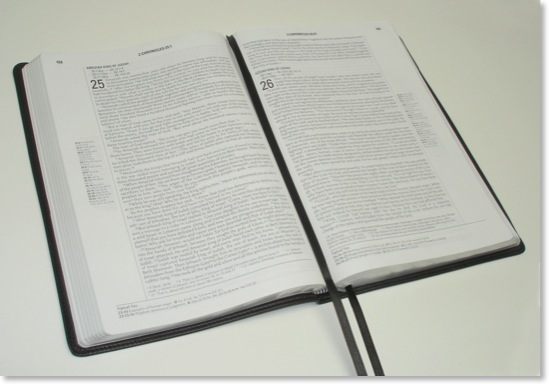
This does, indeed, look to be a very fine Bible. It was described to me in correspondence with these words “I wish you could touch this leather. Smooth as butter. Supple. Exquisite.”
Now, I know that Zondervan has promised to give away some of these Bibles through TC Robinson’s New Leaven website. But today they also contacted me and have generously offered to do something similar through This Lamp.
I’ll spell out the particulars in a day or two, so be sure to stay tuned for more...









